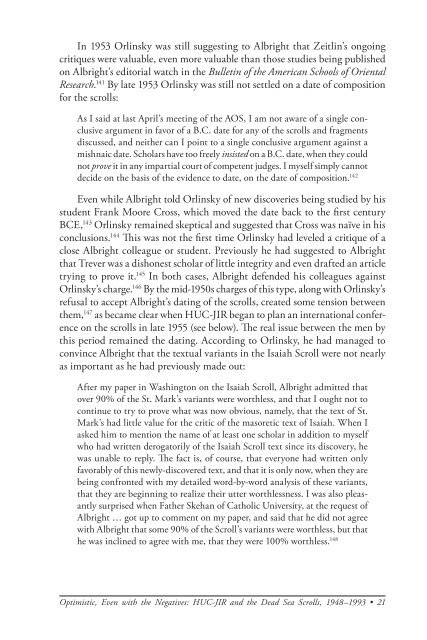The American Jewish Archives Journal, Volume LXI 2009, Number 1
The American Jewish Archives Journal, Volume LXI 2009, Number 1
The American Jewish Archives Journal, Volume LXI 2009, Number 1
Create successful ePaper yourself
Turn your PDF publications into a flip-book with our unique Google optimized e-Paper software.
In 1953 Orlinsky was still suggesting to Albright that Zeitlin’s ongoing<br />
critiques were valuable, even more valuable than those studies being published<br />
on Albright’s editorial watch in the Bulletin of the <strong>American</strong> Schools of Oriental<br />
Research. 141 By late 1953 Orlinsky was still not settled on a date of composition<br />
for the scrolls:<br />
As I said at last April’s meeting of the AOS, I am not aware of a single conclusive<br />
argument in favor of a B.C. date for any of the scrolls and fragments<br />
discussed, and neither can I point to a single conclusive argument against a<br />
mishnaic date. Scholars have too freely insisted on a B.C. date, when they could<br />
not prove it in any impartial court of competent judges. I myself simply cannot<br />
decide on the basis of the evidence to date, on the date of composition. 142<br />
Even while Albright told Orlinsky of new discoveries being studied by his<br />
student Frank Moore Cross, which moved the date back to the first century<br />
BCE, 143 Orlinsky remained skeptical and suggested that Cross was naïve in his<br />
conclusions. 144 This was not the first time Orlinsky had leveled a critique of a<br />
close Albright colleague or student. Previously he had suggested to Albright<br />
that Trever was a dishonest scholar of little integrity and even drafted an article<br />
trying to prove it. 145 In both cases, Albright defended his colleagues against<br />
Orlinsky’s charge. 146 By the mid-1950s charges of this type, along with Orlinsky’s<br />
refusal to accept Albright’s dating of the scrolls, created some tension between<br />
them, 147 as became clear when HUC-JIR began to plan an international conference<br />
on the scrolls in late 1955 (see below). <strong>The</strong> real issue between the men by<br />
this period remained the dating. According to Orlinsky, he had managed to<br />
convince Albright that the textual variants in the Isaiah Scroll were not nearly<br />
as important as he had previously made out:<br />
After my paper in Washington on the Isaiah Scroll, Albright admitted that<br />
over 90% of the St. Mark’s variants were worthless, and that I ought not to<br />
continue to try to prove what was now obvious, namely, that the text of St.<br />
Mark’s had little value for the critic of the masoretic text of Isaiah. When I<br />
asked him to mention the name of at least one scholar in addition to myself<br />
who had written derogatorily of the Isaiah Scroll text since its discovery, he<br />
was unable to reply. <strong>The</strong> fact is, of course, that everyone had written only<br />
favorably of this newly-discovered text, and that it is only now, when they are<br />
being confronted with my detailed word-by-word analysis of these variants,<br />
that they are beginning to realize their utter worthlessness. I was also pleasantly<br />
surprised when Father Skehan of Catholic University, at the request of<br />
Albright … got up to comment on my paper, and said that he did not agree<br />
with Albright that some 90% of the Scroll’s variants were worthless, but that<br />
he was inclined to agree with me, that they were 100% worthless. 148<br />
Optimistic, Even with the Negatives: HUC-JIR and the Dead Sea Scrolls, 1948–1993 • 21

















